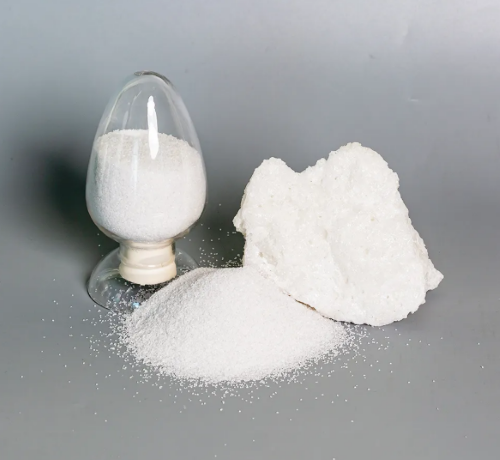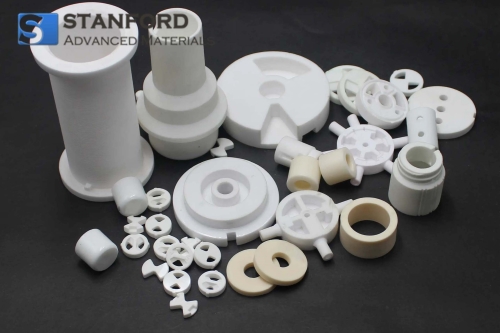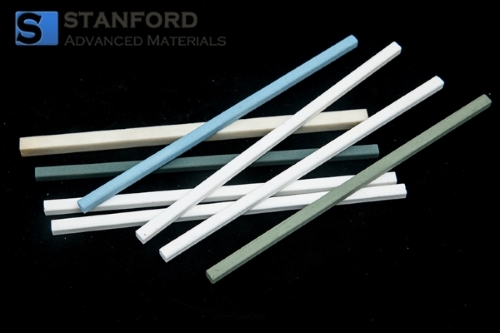Aluminum Oxide: Properties, Applications, And Production
Introduction
Aluminium oxide (Al₂O₃), known as alumina, possesses high hardness, thermal stability and chemical inertness. It is used in a range of industries, including abrasives, electronics, medical devices and other sectors. This article details the properties, applications and production methods of aluminium oxide. We trust that the provided data clarifies why it remains an essential material in modern technology and manufacturing.
What is Aluminium Oxide
Aluminium oxide is a crystalline compound composed of aluminium and oxygen. It occurs naturally as corundum, a mineral that forms the basis for gemstones such as rubies and sapphires. In industry it is synthesised through refining processes and, owing to its durability and wear resistance, is employed in ceramics, electronics and protective coatings.
Stanford Advanced Materials (SAM) offers a range of aluminium oxide ceramic products for various applications:
- Aluminium oxide ceramics are used in sectors such as aerospace, automotive and electronics for electrical insulators and structural components.
- Aluminium oxide substrates and housings provide thermal management and electrical insulation for electronic devices.
- Owing to its hardness and abrasion resistance, the material is employed in abrasive and polishing applications.

Properties and Features
Aluminium oxide is characterised by a specific set of properties that render it valuable in many technical applications:
- High hardness and strength: With a Mohs hardness of 9, Al₂O₃ is among the hardest materials available after diamond. Its compressive strength is approximately 2 000 MPa, making it suitable for use in abrasives, cutting tools and wear‐resistant coatings.
- Excellent thermal stability: Al₂O₃ has a melting point of 2 072°C (3 762°F) and remains stable at elevated temperatures. It is applied in furnace linings, high temperature insulation and fire‐resistant contexts.
- Chemical inertness: It is highly resistant to corrosion and exhibits minimal reactivity with most acids or bases. Its solubility in water is less than 0.0001 g per 100 mL at room temperature, thereby ensuring reliable performance in chemically aggressive environments.
- Electrical insulation: With a dielectric breakdown strength of about 15 kV/mm, Al₂O₃ functions efficiently as an electrical insulator in electronic components, circuit substrates and semiconductors.
- Biocompatibility: Owing to its non-toxic and non-reactive nature, it is utilised in medical and dental applications such as hip prostheses, dental implants and bone graft procedures. It also exhibits high wear resistance in biological conditions, which contributes to the longevity of implants.

Summary Table: Chemical, Physical, Thermal and Mechanical Properties
|
Property Category |
Property |
Value/Description |
|
Chemical Properties |
Chemical Formula |
|
|
Molecular Weight |
101.96 g/mol |
|
|
Solubility in Water |
< 0.0001 g/100 mL (practically insoluble) |
|
|
Chemical Resistance |
Resistant to most acids and bases; inert in aggressive chemical environments |
|
|
Biocompatibility |
Non-toxic, non-reactive; suitable for medical and dental applications |
|
|
Physical Properties |
Density |
3.95–4.1 g/cm³ |
|
Colour |
White or colourless (in pure form); may vary with impurities (e.g. in rubies, sapphires) |
|
|
Crystal Structure |
Hexagonal (corundum structure) |
|
|
Mohs Hardness |
9 (second highest after diamond) |
|
|
Surface Finish |
Smooth, polishable |
|
|
Thermal Properties |
Melting Point |
2 072°C (3 762°F) |
|
Thermal Conductivity |
20–30 W/m-K |
|
|
Thermal Expansion |
6–8 × 10⁻⁶ /K |
|
|
Thermal Stability |
High; stable at elevated temperatures |
|
|
Mechanical Properties |
Compressive Strength |
~2 000 MPa |
|
Flexural Strength |
300–400 MPa |
|
|
Tensile Strength |
200–300 MPa |
|
|
Elastic Modulus |
300–400 GPa |
|
|
Fracture Toughness |
3–4 MPa-m¹/² |
|
|
Electrical Properties |
Dielectric Strength |
~15 kV/mm |
|
Dielectric Constant |
~9–10 (at 1 MHz) |
|
|
Electrical Resistivity |
>10¹⁴ Ω-cm (excellent insulator) |
Applications of Aluminium Oxide
Aluminium oxide is used across a range of industries due to its measured properties. The principal applications include:
- Abrasives and cutting tools: Its hardness is employed in sandpaper, grinding wheels and cutting tools used for surface finishing.
- Refractory materials and ceramics: Its high temperature resistance qualifies it for use in furnace linings, furnace insulation and high-performance ceramics.
- Electronics and semiconductors: Its electrical insulating properties render it necessary in printed circuit boards, semiconductors and capacitor dielectrics.
- Medical and dental applications: Its biocompatibility permits its use in dental implants, joint prostheses and other medical devices.
- Catalysts and chemical processing: Alumina serves as a catalyst or catalyst support in petrochemical refining and chemical reactions.
- Glass and coatings: It is used in scratch-resistant coatings for glass, optical applications and protective coatings for metals.

Production of Aluminium Oxide
Aluminium oxide is produced primarily by the Bayer process and by calcination.
- Bayer Process:
1. Crushing and Grinding: Bauxite ore is ground into a fine powder.
2. Digestion: The powder is mixed with hot, concentrated sodium hydroxide solution, which dissolves the aluminium oxide and leaves the impurities behind.
3. Clarification: The solution is filtered to remove impurities.
4. Precipitation: Aluminium hydroxide is precipitated by cooling the solution and adding aluminium hydroxide crystals as seeds.
5. Calcination: The aluminium hydroxide is heated to 1 000–1 200 °C to remove water and produce pure aluminium oxide (Al₂O₃).
Bauxite ore
↓
Crushing & Grinding
↓
Powder
↓
Digestion
(mixing with sodium hydroxide)
↓
Dissolved Al₂O₃ and impurities
↓
Clarification
(filtering impurities)
↓
Clear solution
↓
Precipitation
(cooling & seeding with Al(OH)₃ crystals)
↓
Aluminium hydroxide precipitate (Al(OH)₃)
↓
Calcination
(heating at 1 000–1 200 °C)
↓
Pure aluminium oxide (Al₂O₃)
- Calcination Process:
Aluminium hydroxide or other aluminium compounds are heated to remove bound water and convert them into aluminium oxide. This method is used alongside the Bayer process to refine the final product.
- Alternative Methods:
- Production of fused aluminium oxide: Aluminium oxide is melted and then rapidly cooled to form a hard, crystalline material used in abrasives and ceramics.
- Chemical vapour deposition (CVD): This technique is employed to produce thin layers of aluminium oxide for electronic and optical applications.
Conclusion
Aluminium oxide is a material used in abrasives, electronics, medical devices and chemical processing. Its quantified properties of high hardness, thermal stability, chemical inertness and effective electrical insulation ensure its role in modern manufacturing. The data provided in this article support a clear understanding of its industrial relevance. Advances in industry maintain aluminium oxide as a fundamental material in various sectors.

 Bars
Bars
 Beads & Spheres
Beads & Spheres
 Bolts & Nuts
Bolts & Nuts
 Crucibles
Crucibles
 Discs
Discs
 Fibers & Fabrics
Fibers & Fabrics
 Films
Films
 Flake
Flake
 Foams
Foams
 Foil
Foil
 Granules
Granules
 Honeycombs
Honeycombs
 Ink
Ink
 Laminate
Laminate
 Lumps
Lumps
 Meshes
Meshes
 Metallised Film
Metallised Film
 Plate
Plate
 Powders
Powders
 Rod
Rod
 Sheets
Sheets
 Single Crystals
Single Crystals
 Sputtering Target
Sputtering Target
 Tubes
Tubes
 Washer
Washer
 Wires
Wires
 Converters & Calculators
Converters & Calculators
 Write for Us
Write for Us

 Chin Trento
Chin Trento



